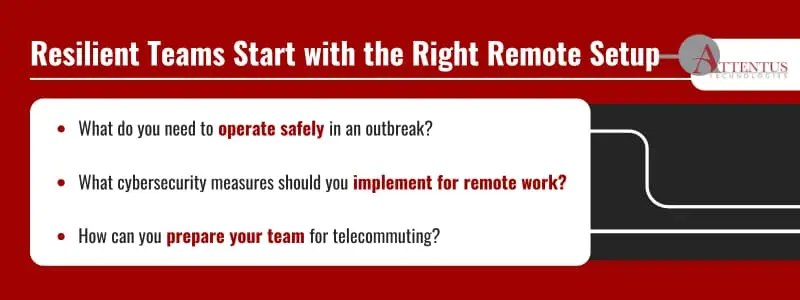Emergencies come without notice. Make sure you’re ready for when they do.

Is your business equipped for remote operations during an outbreak?
Unplanned health incidents can force sudden shifts in your team’s work and interactions, so it pays to prepare.
Take COVID-19, for example. Millions of people got sick and didn’t have the strength to go to work for days, sometimes weeks. Many of those who could were reluctant to go to the office because they feared contracting the virus.
And then, governments worldwide placed mobility restrictions as a containment measure. Businesses that hadn’t laid the foundation for digital operations had to quickly cobble together remote work tools to allow their employees to telecommute.
Although COVID-19 is now behind us, similar incidents could still occur. Airfinity, a leading analytics firm that monitors and forecasts global health trends, even predicts a 27.5% likelihood of a COVID-like crisis by 2033.
Businesses face other scenarios requiring flexible work arrangements, too. An employee may become ill at any moment and be unable to report to work–despite their desire to–or a family member could fall sick and require their help at home. Without robust capabilities to accommodate these situations, your team faces a tough choice between health and work responsibilities, and they will rightly prioritize health.
The good news is that it doesn’t have to come down to that choice. With the correct setup, you can support your team through difficult times, empower them to work from home, and ensure operations remain uninterrupted.
What Do You Need For Operating Safely in an Outbreak?
What’s the first thing that comes to mind when setting up your team for remote work? It’s likely the technology factor:
- What tools will you use?
- Do they allow your team to share files, communicate, and collaborate seamlessly?
- Are they safe?
- How much do they cost?
Platforms like Microsoft Teams, Slack, Atom, and Github can help your geographically dispersed team access essential resources on demand and maintain a standard workflow. Choose the one that fits your collaboration needs and budget.
You’ll also want to ensure employees have the right equipment. One approach is to offer your team a home office stipend for essential equipment, or have them purchase it and then reimburse the cost. Alternatively, you could adopt a “bring your own device” (BYOD) policy where employees use their own PCs, laptops, tablets, and phones for work.
What about communication?
Since in-person collaboration opportunities will be restricted, establish a regular communication cadence using your tools of choice. Weekly one-on-one meetings can provide excellent opportunities to discuss goals, upcoming projects, and pending issues or concerns. Everyone stays up to speed with developments and aligned with the organization.
Remember to set clear expectations. Establish explicit communication protocols, scheduling, availability, and workflows from the onset. This will eliminate potential frustrations, confusion, and misalignment. Everyone having visibility into each other’s availability and deadlines will help better coordinate work and ensure appropriate coverage of critical functions, for example.
Which Security Measures Should Be Top of Mind When Employees Telecommute?
Telecommuting considerably expands your attack surface and limits visibility into your technology estate. Recent surveys show remote work vulnerabilities now cause one in five data breaches. These events typically include:
- Unsecured personal devices
- Unsecured Wi-Fi networks
- Misconfigured cloud settings
- Unsafe file-sharing protocols
- Employee complacency (E.g., ignoring security best practices)
What can you do about these risks?
1. Create a comprehensive information security program
Your written policy should clearly outline the organization’s stance on security and guidelines for remote work. What will the repercussions be for employees who violate the policy? Make sure everyone on the team understands the policy inside out.
2. Double down on employee training
Now is a great time to raise awareness about the most preeminent threats remote work poses. Educating employees about simple practices like updating their software on time, avoiding public Wi-Fi, locking laptops when not in use, and being aware of their surroundings when viewing confidential information can considerably improve cybersecurity.
3. Establish secure remote access with a VPN
A virtual private network (VPN) encrypts information transmitted to and from employees’ computers, thereby ensuring they can access a corporate network without adversaries intercepting critical data.
4. Implement strong authentication mechanisms and access controls
Multi-factor authentication (MFA) thwarts 99.9% of account compromise attempts, according to Microsoft, so it should be standard for all user accounts. Always require employees to enter a code sent to their phone, email, or authenticator app, scan their fingerprint, or go through some other verification process beyond inputting their password.
Access privileges should be established based on users’ roles and responsibilities. This prevents adversaries from moving laterally across the network if they get in. It also limits the damage a disgruntled employee can inflict on your organization should they go rogue.
Attentus Technologies Can Help You Safely Transition To Remote Work
Setting up a robust remote work environment that’s ready to help you hit the ground running from day one is no easy task. Luckily, Attentus Technologies has helped many forward-thinking SMBs do precisely that.
One of our core values is to be the answer when companies need technology solutions like these, so don’t go it alone. Leverage a trusted partnership with Attentus. We’ll help you figure out which tools you need and create solid security controls around them so they can safely operate in an outbreak or other health crisis.
With a client retention rate of over 10 years and a 98.4% customer satisfaction score, we’ve proven our commitment to long-term relationships and high-quality service. Plus, with our flexible model, you only pay for what you need—nothing more, nothing less.
Get in touch to learn more.
